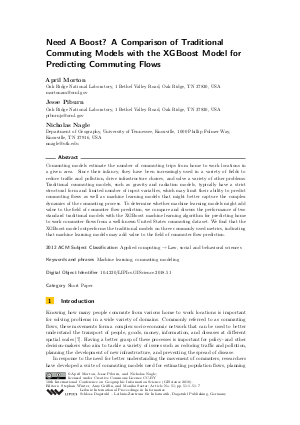Need A Boost? A Comparison of Traditional Commuting Models with the XGBoost Model for Predicting Commuting Flows (Short Paper)
Authors April Morton, Jesse Piburn, Nicholas Nagle
-
Part of:
Volume:
10th International Conference on Geographic Information Science (GIScience 2018)
Part of: Series: Leibniz International Proceedings in Informatics (LIPIcs)
Part of: Conference: International Conference on Geographic Information Science (GIScience) - License:
 Creative Commons Attribution 3.0 Unported license
Creative Commons Attribution 3.0 Unported license
- Publication Date: 2018-08-02
File

PDF
LIPIcs.GISCIENCE.2018.51.pdf
- Filesize: 394 kB
- 7 pages
Document Identifiers
Subject Classification
ACM Subject Classification
- Applied computing → Law, social and behavioral sciences
Keywords
- Machine learning
- commuting modeling
Metrics
- Access Statistics
-
Total Accesses (updated on a weekly basis)
0Document
0Metadata
Abstract
Commuting models estimate the number of commuting trips from home to work locations in a given area. Since their infancy, they have been increasingly used in a variety of fields to reduce traffic and pollution, drive infrastructure choices, and solve a variety of other problems. Traditional commuting models, such as gravity and radiation models, typically have a strict structural form and limited number of input variables, which may limit their ability to predict commuting flows as well as machine learning models that might better capture the complex dynamics of the commuting process. To determine whether machine learning models might add value to the field of commuter flow prediction, we compare and discuss the performance of two standard traditional models with the XGBoost machine learning algorithm for predicting home to work commuter flows from a well-known United States commuting dataset. We find that the XGBoost model outperforms the traditional models on three commonly used metrics, indicating that machine learning models may add value to the field of commuter flow prediction.
Cite As Get BibTex
April Morton, Jesse Piburn, and Nicholas Nagle. Need A Boost? A Comparison of Traditional Commuting Models with the XGBoost Model for Predicting Commuting Flows (Short Paper). In 10th International Conference on Geographic Information Science (GIScience 2018). Leibniz International Proceedings in Informatics (LIPIcs), Volume 114, pp. 51:1-51:7, Schloss Dagstuhl – Leibniz-Zentrum für Informatik (2018)
https://doi.org/10.4230/LIPIcs.GISCIENCE.2018.51
BibTex
@InProceedings{morton_et_al:LIPIcs.GISCIENCE.2018.51,
author = {Morton, April and Piburn, Jesse and Nagle, Nicholas},
title = {{Need A Boost? A Comparison of Traditional Commuting Models with the XGBoost Model for Predicting Commuting Flows}},
booktitle = {10th International Conference on Geographic Information Science (GIScience 2018)},
pages = {51:1--51:7},
series = {Leibniz International Proceedings in Informatics (LIPIcs)},
ISBN = {978-3-95977-083-5},
ISSN = {1868-8969},
year = {2018},
volume = {114},
editor = {Winter, Stephan and Griffin, Amy and Sester, Monika},
publisher = {Schloss Dagstuhl -- Leibniz-Zentrum f{\"u}r Informatik},
address = {Dagstuhl, Germany},
URL = {https://drops.dagstuhl.de/entities/document/10.4230/LIPIcs.GISCIENCE.2018.51},
URN = {urn:nbn:de:0030-drops-93793},
doi = {10.4230/LIPIcs.GISCIENCE.2018.51},
annote = {Keywords: Machine learning, commuting modeling}
}
Author Details
References
-
Ethem Alpaydin. Introduction to machine learning. MIT Press, 2014.

- United States Census Bureau. Block group shapefiles for Tennessee [data file], 2010. URL: https://www.census.gov/geo/maps-data/.
- United States Census Bureau. LEHD Origin-destination employment statistics [dataset], 2010. URL: https://lehd.ces.census.gov/data/.
-
Tianqi Chen and Carlos Guestrin. Xgboost: A scalable tree boosting system. In Proceedings of the 22nd ACM SIGKDD International Conference on Knowledge Discovery and Data Mining, pages 785-794. ACM, 2016.

-
Andrea De Montis, Marc Barthélemy, Alessandro Chessa, and Alessandro Vespignani. The structure of interurban traffic: a weighted network analysis. Environment and Planning B: Planning and Design, 34(5):905-924, 2007.

-
Sven Erlander and Neil F Stewart. The gravity model in transportation analysis: theory and extensions, volume 3. VSP, 1990.

-
Maxime Lenormand, Aleix Bassolas, and José J Ramasco. Systematic comparison of trip distribution laws and models. Journal of Transport Geography, 51:158-169, 2016.

-
Celik H Murat. Sample size needed for calibrating trip distribution and behavior of the gravity model. Journal of Transport Geography, 18(1):183-190, 2010.

-
Caleb Robinson and Bistra Dilkina. A machine learning approach to modeling human migration. arXiv preprint arXiv:1711.05462, 2017.

-
Jan Rouwendal and Peter Nijkamp. Living in two worlds: a review of home-to-work decisions. Growth and Change, 35(3):287-303, 2004.

